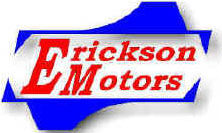MCC Engine FAQs
This web page provides answers to questions that modelers have asked us about our Erickson MCC FE-120 and FE-200 model engines.
Q: Do MCC Engines run hot and can they be cowled in?
A: The exhaust of MCC Engines runs cooler than standard engines because we use more of the thermal energy before exhausting. Our typical exhaust temperature is 350º or a little hotter. Since more heat is kept in the engine to do additional work, this causes our entire engine to become hot during operation. The engine will cool properly if good airflow is allowed to travel past the cooling fins during operation. MCC engines can be cowled in as long as air flow past the cooling fins is not restricted. We also recommend that you run the engine a little on the rich side to help keep it cooler. Since MCC Engines use large propellers, most of the cooling effect of the propeller wash does not reach the engine. This makes the cooling effect provided by flying more important. It is alright to operate the engine on the ground at low power levels, but only run the engine for a short duration at medium to high power levels to prevent overheating it.
Q: Do MCC Engines need a starter to start them?
A: We recommend the use of a high torque starter for our engines. The FE-120 requires a Sullivan DynaTron 12/24 volt starter with 18 to 24 volts. Our larger engine, the FE-200, requires a Sullivan DynaTron 12/24 volt starter with a Persuader (From Miller R/C Products) belt reduction unit and 18 to 24 volts of power. Using the correct starter with our engines makes starting safer and easier when the engine is hot or a little flooded. MCC Engines are easier to start when they are cool.
Q: Do MCC Engines require a fuel pump?
A: This really depends on the type of flying and fuel tank location. If the tank is close to the engine and level with the carburetor then you may not require a fuel pump. A fuel pump will give the most reliable fuel delivery to the engine. Our engines have a pressure tap on the back of the power block that will provide the positive and negative pressure pulses that are needed to operate most pumps. You must connect to the pressure tap with silicone fuel tubing or the heat of the engine will melt the pressure line. Using the pressure tap to pressurize the tank without a pump or fuel metering device will cause the engine to flood. If you do not use the pressure tap, then be sure to keep it capped off with the plug that is provided with the engine.
